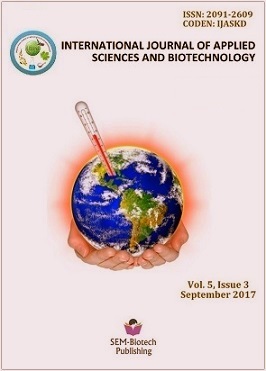Isolation of Ethidium Bromide Degrading Bacteria from Jharkhand
DOI:
https://doi.org/10.3126/ijasbt.v5i3.18296Keywords:
EtBr, Bioremediation, Biodegradation, Non-fluorescent-haloAbstract
Ethidium bromide (EtBr) is a carcinogenic and mutagenic agent which is widely used in research laboratories to probe nucleic acids by gel electrophoresis. It is generally buried underground (for solid waste) or disposed of pouring it down the sink (in case of liquid waste). Soil or drain microbial community may be able to take care of such substance else it will lead to contamination of our underground resources or others through defined and undefined routes. In view of the above assumption and literature reports the present study was undertaken to isolate and evaluate bacteria for removal, by bioaccumulation and /or biotransformation, of EtBr from contaminated sources and wastes, before their disposal to the environment. Two distinct bacteria both motile BR3 and BR4 could be identified from agarose-gel-waste containing 0.5-1.0 µg/ml ethidium bromide. Both bacteria were found to grow on EtBr-NA plate (Nutrient-Agar supplemented with EtBr at a concentration of 30 µg/ml) however only BR3 isolate showed large non-fluorescent-halo zone (characteristic to degradation of EtBr) when exposed to trans-UV light. Other isolate BR4 could accumulate EtBr within the colony biomass but did not showed clear (non-fluorescent) hallow zone around it. However the bacterium is not able to utilize the EtBr as a sole carbon source.
Int. J. Appl. Sci. Biotechnol. Vol 5(3): 293-301




